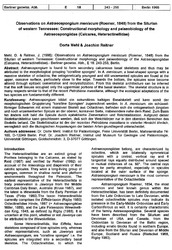Observations on Astraeospongium meniscum (Roemer, 1948) from the Silurian of western Tennessee; constructional morphology and palaeobiology of the Astraeospongiidae (Calcarea, Heteractinellidae)
Zeitschrift: Berliner geowissenschaftliche Abhandlungen : Reihe E, 199618: 243 - 255
Mehl, Dorte; Reitner, Joachim, 1996: Observations on Astraeospongium meniscum (Roemer, 1948) from the Silurian of western Tennessee; constructional morphology and palaeobiology of the Astraeospongiidae (Calcarea, Heteractinellidae). In: Mehl, Dorte; Reitner, Joachim (1996): Observations on Astraeospongium meniscum (Roemer, 1948) from the Silurian of western Tennessee ; constructional morphology and palaeobiology of the Astraeospongiidae (Calcarea, Heteractinellidae) - Berliner geowissenschaftliche Abhandlungen : Reihe E; Vol. 18, p. 243-255, DOI: 10.23689/fidgeo-2541.
 |
Dokument öffnen: |
Astraeospongium is found to form secondary calcareous basal skeletons and thus may be
attributed to the morphological grouping "coralline sponges". In A. meniscum, a bowl-shaped sponge with a
massive skeleton of octactins, the ontogenetically youngest and still uncemented spicules are found at the
upper, concave surface, particularly close to the edge. Towards the bottom, the spicules soon become
altered through epitaxic cementation and recrystallization. From this skeletal architecture can be inferred
that the soft tissues occupied only the uppermost portions of the basal skeleton. The skeletal structure is in
many respects similar to that of the recent Petrobiona massiliana, although the ecological adaptations of the
two species are fundamentally different. Astraeospongium bildet ein sekundäres kalkiges Basalskelett und kann somit der
morphologischen Gruppierung "koralline Spongien" zugerechnet werden. In A. meniscum, ein schüsseIförmiger
Schwamm mit einem massiven Skelett aus Octactinen, befinden sich die ontogenetisch jüngsten
und noch unzementierten Spicula an der oberen, konkaven Seite, insbesondere nahe dem Rand. Zum Basis
hin ändern sich bald die Spicula durch epitaktische Zementation und Rekristallisation. Aufgrund dieser
Skelettarchitektur kann geschlossen werden, daß sich der Weichkörper nur in den obersten Bereichen des
Skeletts befand. Die Skelettstruktur ist der der rezenten Petrobiona massiliana in vielerlei Hinsicht ähnlich,
wenngleich sich die ökologischen Anpassungen der beiden Arten grundlegend unterscheidet.
Statistik:
ZugriffsstatistikSammlung:
- Geologie [930]

